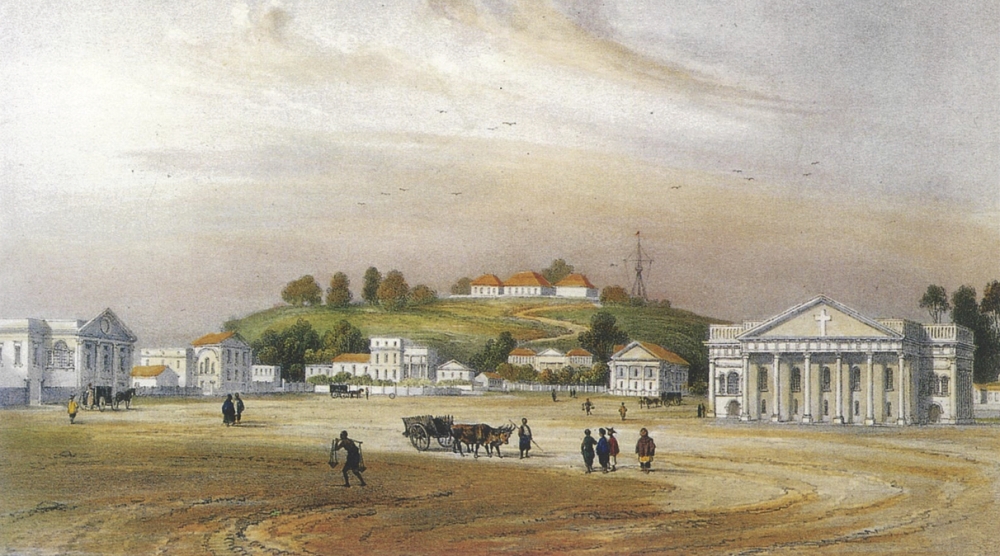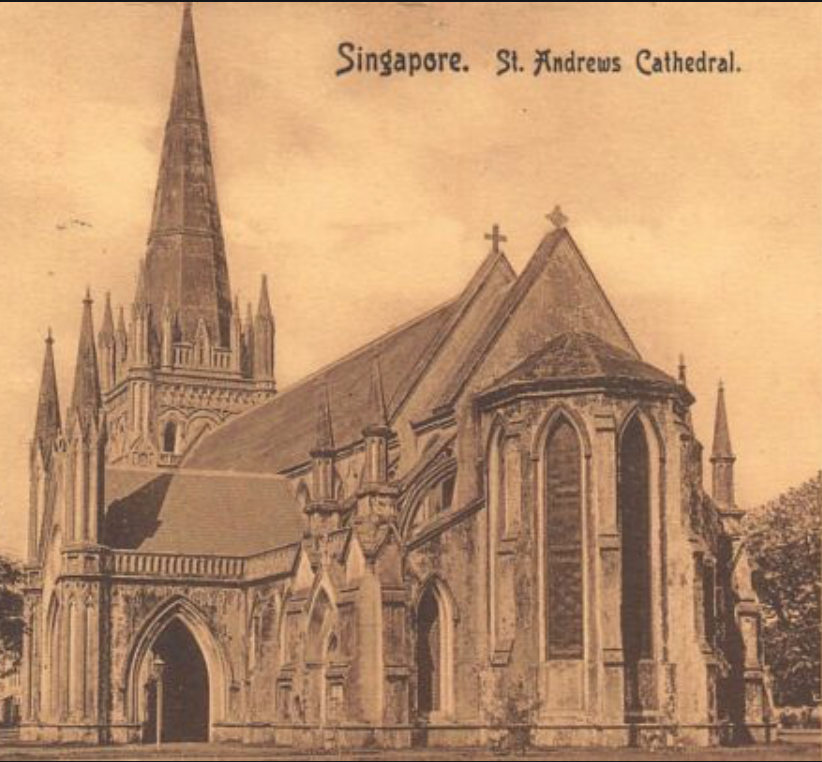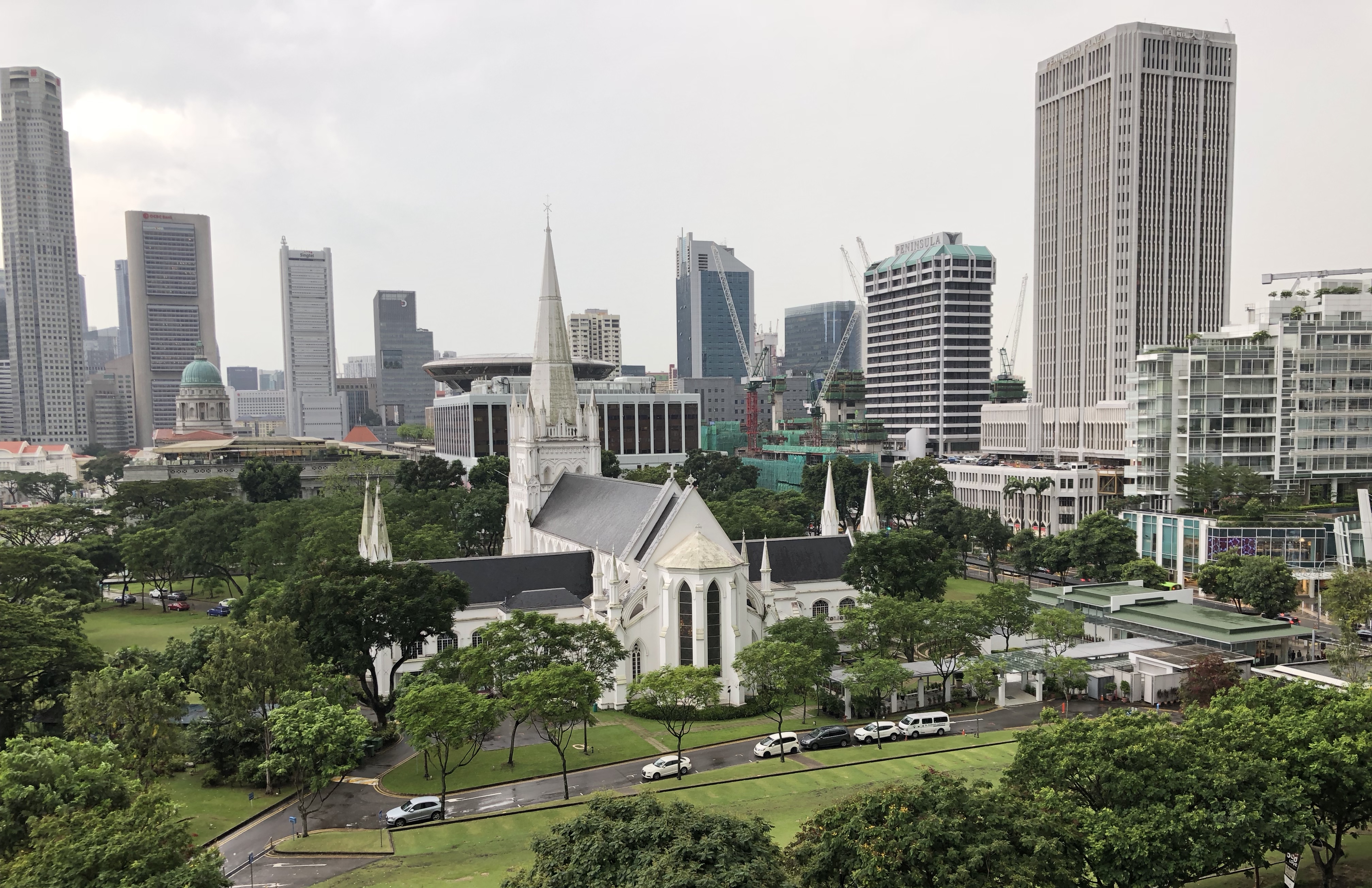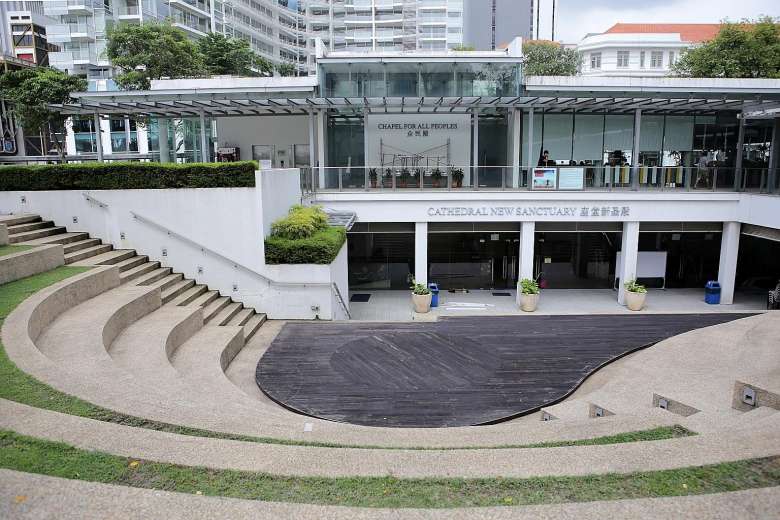We are heirs to the past, stewards of the present and trustees for the future.
- 1959 St Andrew’s Cathedral Stewardship Campaign Brochure
-
IN THE BEGINNING
"The structure must be neat, convenient, commodious, and elegant, such as would adorn the neighbourhood, and be suitable for that very admirable site which has already been allotted, and was long ago intended for the purpose." – Bishop Daniel Wilson’s 1834 address to the committee set up to build the first church.

Following the establishment of a British trading port settlement by Sir Stamford Raffles in January 1819, the population grew quickly, along with trade and economic activity. There was also a need to therefore regulate certain matters. To this end, Sir Stamford Raffles appointed and instructed the colony’s engineer, Lieutenant Philip Jackson, to draw up reconstruction plans in 1822.
Land was demarcated in a grid pattern for different residential ethnic groups, trade, and public activities. The Jackson Plan also included provisions for a church located in the heart of the civic district, along with government buildings and European homes.

Painting of an early view of St Andrew’s Church from the seafront with Government Hill, present-day Fort Canning in the background (National Archives of Singapore). Initially, the Anglican community worshipped in a wooden and thatch-roofed mission chapel located where Raffles Hotel is today. It was the Revd Fred J. Darrah, Chaplain for the Mission Chapel, who desired a proper house of worship. He convened a meeting on Monday, 6th October 1834, and sufficient funds were raised to start building a church on land allocated by Raffles ten years ago. A substantial portion of the initial funds was raised by the Scottish community. Hence, the church was named after Saint Andrew, one of the 12 Apostles of Christ and the patron saint of Scotland.
Some have noted that the present cathedral is not located "correctly" on the Jackson Plan. However, the plan was never intended to be a definitive representation of actual land use or the church’s location. A more accurate depiction appears in the map based on a later land survey carried out by G. D. Coleman, the architect of the first St Andrew’s Church.
-
THE FIRST BUILDING
St Andrew’s Cathedral is the oldest Anglican site of worship in Singapore. While much is known about the cathedral’s existing building, relatively little is known about the previous church building, which had its first foundation stone laid on Monday 9th November 1835.

A 1919 picture of the existing building St Andrew’s Church was fashioned in the Neo-Classical architectural style of Singapore’s pioneer colonial architect G. D. Coleman, who was inspired by the symmetrical sensibilities of classical Greek and Roman architecture. The church held its first service on 18 June 1837 and was consecrated a year later by the Right Revd Daniel Wilson, the Bishop of Calcutta who had jurisdiction over Singapore.
In 1842, a spire was added to “distinguish the sacred edifice” from surrounding civic buildings. Unfortunately, the spire was struck twice by lightning in 1845 and 1849. While there were no injuries, church services were discontinued in 1852 for safety reasons. In 1855, plans for the new church building were approved.
-
THE CURRENT BUILDING
The foundation stone for the cathedral’s present building was laid in 1856. The first service was held on 1st October 1861 and consecrated in 1862 and designed by Colonel Ronald MacPherson in the neo-Gothic architectural style. The building accommodated around 300 seated worshippers. Its grand façade would have been particularly prominent from the sea then. For the Christian community in Singapore, it was a sign of unity and acted as a powerful stimulus for new missionary work in the region.

The Cathedral today John F. A. McNair was appointed executive engineer and superintendent of convicts in 1857. Fluent in Hindi, McNair had only one European assistant while the rest of his crew were convict labourers from India. Babajee or Bawajee Rajaram from Bombay headed the team of draughtsmen. Another convict Appasamy as the foreman of the blacksmith’s shop did the ironwork. Boy convicts were trained to climb up to place imported slates on the new steeple.
Though it cannot be compared to the grand architectural projects in England around the same time, it is a unique building erected with limited funds. The newspapers then reported that the total cost of church building came to 47,916 Indian Rupees with the use of Indian convict labour. The use of convict labour for the building of a Cathedral is often a subject of comment. Many buildings in Singapore at that time were built in this way.
Unlike the earlier building, the present structure has lasted for more than 150 years, standing as a quiet witness to the generations of Christians that have come through its doors. It is an oasis in the heart of a bustling city-state. The building consists of a nave with north and south aisles. The north and south transepts, originally built as porches for carriages, have in more recent years (North Transept -1952, South Transept - 1983) been extended to provide halls, meeting rooms and offices.
-
AN EXTENSION

The Cathedral New Sanctuary An ambitious extension project “Cathedral New Sanctuary” was started in November 2003. On street level, there is the Cathedral Welcome Centre and The Chapel of All Peoples. Extending two storeys below street level is an underground worship hall. This extension was completed and consecrated in 2005 by Bishop John Chew.
-
TIMELINE OF OUR CATHEDRAL
1823 Present site chosen for a church by Sir Stamford Raffles 1834 Foundation stone of first Anglican church in Singapore laid on present site 1837 First Divine Service conducted by the first Chaplain, Revd Edmund White 1838 Consecration of St Andrew’s Church 1852 Closed after being struck twice by lightning and declared unsafe 1856 Foundation stone of present building laid by Bishop of Calcutta 1862 Present building consecrated 1870 St Andrew’s Church becomes the Cathedral of the Diocese of Labuan and Sarawak 1938 100th Anniversary 1942 Cathedral was used as an emergency hospital before the fall of Singapore 1952 Completion of North Transept extension 1954 Beginning of Mandarin Congregation - First Mandarin Service conducted by Revd Canon Sverre Holth 1973 Cathedral gazetted as National Monument 1983 Completion of South Transept Extension 1988 150th Anniversary 1989 Construction of baptistry 2005 Completion of Cathedral New Sanctuary and extension 2012 150th Anniversary of Consecration of St Andrew’s Cathedral Building
HISTORICAL HIGHLIGHTS
Revisit memories from our past through in-depth articles, first-hand accounts and more
In Remembrance
- In Memory of Her Majesty Queen Elizabeth II
Her Majesty, Queen Elizabeth II, passed away on September 8, 2022. This obituary recounts her first visit to Singapore when she attended a special service at St Andrew's Cathedral in February 1972. - Unity of Faith: The Story of St Andrew's Cathedral During World War II
This documentary details the important story of SAC during the Fall of Singapore. During this dark period, SAC served as a symbol of hope, uniting people from different nations and backgrounds in a time of crisis. - In Memory of His Royal Highness
Prince Philip, the Duke of Edinburgh passed away on April 9, 2021. This obituary details his visit to our Cathedral as well as commemorates his dedication to public service. - An Interview On Elizabeth Choy
Karen Hoisington shares about her grandaunt Elizabeth Choy, a war heroine and symbol of a well-lived Christian faith in this interview. - 121 Signal Squadron
Read more about their history and details of the Remembrance Service held in October 2017 in this article. - Transcending Enemy Lines: Andrew Ogawa
This article brings focus on a Japanese imperial army officer and his contributions to the welfare of the local Cathedral community during the war years.
Artefacts and our Cathedral
- Making The Pipes Speak Again
The majestic and powerful music from organs has long been a staple of churches since medieval days. Come discover the history behind the Cathedral organs and what is to come in the future. - Beneath the Cathedral's New Terracotta Tiles
Learn about the history of the Cathedral's terracotta tiles over the ages and how the new tiles came to be. - Getting To Know Our Bells
Read about the heritage of our Bells, how our peal of bells came to be and what changes are being made. - Ministry of Change-Ringing
More details about the newly installed set of bells and the new sounds they are making. - Conversations In The Bell Tower On New Years Eve 2017
A tongue-in-cheek short story told by Revd Canon Terry Wong, the Cathedral's 7th Vicar, that amuses just as much as it will inform you about the history of the 8 bells that have been hung in our bell tower for over 129 years.


